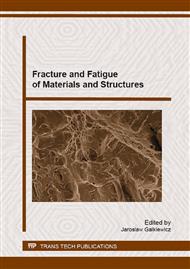[1]
P.G. Kossakowski, Fatigue strength of an over one hundred year old railway bridge, The Baltic Journal of Road and Bridge Engineering. 8, 3 (2013) 166-173, DOI: 10. 3846/bjrbe. 2013. 21.
DOI: 10.3846/bjrbe.2013.21
Google Scholar
[2]
W. Trampczynski et al., Final report on Research Project No. R 04 007 01: Development and preliminary validation of the acoustic emission diagnostic method for metal structures, especially steel bridges (in Polish), Kielce, (2010).
Google Scholar
[3]
W. Wcislik, Experimental determination, numerical determination, and analysis of selected parameters of the Gurson–Tvergaard–Needleman model for S355 steel in complex stress states (in Polish), doctoral dissertation, Kielce University of Technology, Kielce, (2014).
Google Scholar
[4]
L. Mishnaevsky Jr., N. Lippmann, S. Schmauder, Computational modeling of crack propagation in real microstructures of steels and virtual testing of artificially designed materials, International Journal of Fracture. 120 (2003) 581-600.
DOI: 10.1023/a:1025524214322
Google Scholar
[5]
A.S. Argon, S. Im, P. Safoglu, Cavity formation from inclusions in ductile fracture, Metallurgical Transactions. 6A (1975) 825-837.
DOI: 10.1007/bf02672306
Google Scholar
[6]
A.S. Argon, S. Im, Separation of second phase particles in spheroidized 1045 steel, Cu-0. 6pct Cr alloy, and maraging steel in plastic straining, Metallurgical Transactions. 6A (1975) 839-851.
DOI: 10.1007/bf02672307
Google Scholar
[7]
P.W. Bridgman, Studies in Large Plastic Flow and Fracture, McGraw-Hill, New York, (1952).
Google Scholar
[8]
C. Chu, A. Needleman, Void nucleation effects in biaxially stretched sheets, Journal of Engineering Materials and Technology. 102 (1980) 249-256.
DOI: 10.1115/1.3224807
Google Scholar
[9]
P.G. Kossakowski, An analysis of the load-carrying capacity of elements subjected to complex stress states with a focus on the microstructural failure, Archives of Civil and Mechanical Engineering. 10, 2 (2010) 15-39.
DOI: 10.1016/s1644-9665(12)60048-x
Google Scholar
[10]
G. LeRoy, J.D. Embury, G. Edward, M.F. Ashby, A model of ductile fracture based on the nucleation and growth of voids, Acta Metallurgica. 29 (1981) 1509-1522.
DOI: 10.1016/0001-6160(81)90185-1
Google Scholar
[11]
A. Needleman, Void growth in an elastic–plastic medium, Transactions of ASME, Journal of Applied Mechanics. 94 (1972) 964-970.
DOI: 10.1115/1.3422899
Google Scholar
[12]
W. Wcislik, Numerical determination of critical void nucleation strain in the Gurson-Tvergaard-Needleman porous material model for low stress state triaxiality ratio, 23rd International Conference on Metallurgy and Materials Metal 2014, Brno, Czech Republic, 21-23 May, 2014, pp.794-800.
Google Scholar
[13]
P. Kossakowski, W. Wcislik, Effect of critical void volume fraction fF on results of ductile fracture simulation for S235JR steel under multi-axial stress states, Key Engineering Materials. 598 (2014) 113-118.
DOI: 10.4028/www.scientific.net/kem.598.113
Google Scholar


